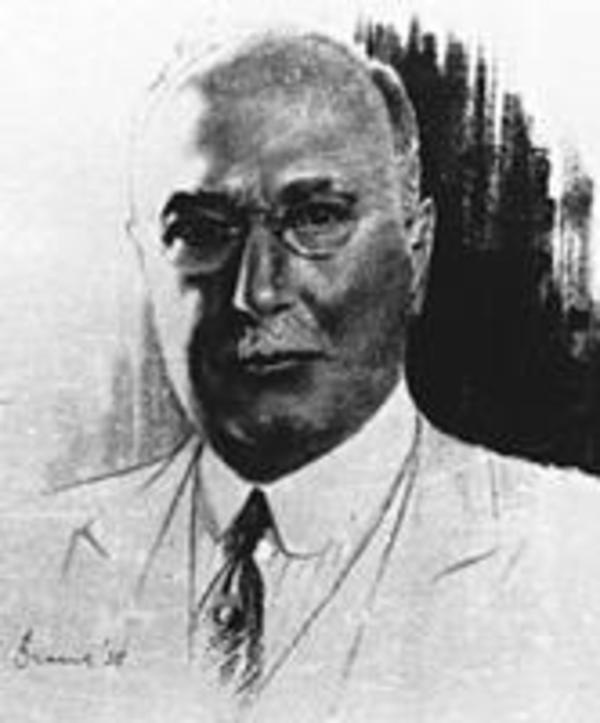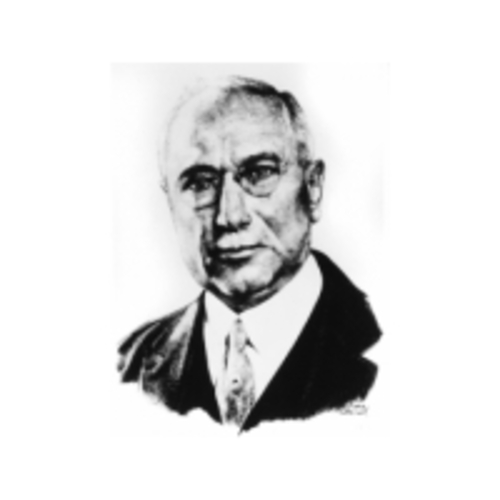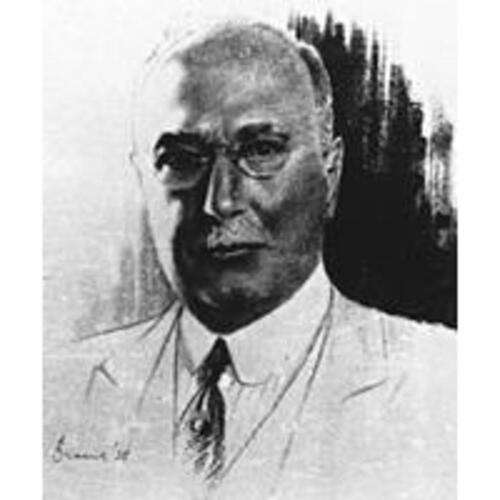
Source: Link
TIMMINS, NOAH ANTHONY (Noé Antoine), merchant, mining developer, and businessman; b. 31 March 1867 in Mattawa, Upper Canada, son of Noah (Noé) Timmins and Henriette (Harriet) Mineur (Miner); m. 9 Feb. 1891 Marie-Joseph-Lilia Paré in Lachine (Montreal), and they had at least five sons and two daughters, one of whom did not live to adulthood; d. 23 Jan. 1936 in Palm Beach, Fla, and was buried in Montreal’s Notre-Dame-des-Neiges cemetery.
The son of an Irish Canadian father and a French Canadian mother, Noah Timmins was raised as a bilingual Roman Catholic in the frontier community of Mattawa, at the confluence of the Ottawa and Mattawa rivers. For centuries, this site had been an important nexus connecting the St Lawrence region to Canada’s vast interior, and the arrival of the Canadian Pacific Railway in autumn 1881 ensured that Mattawa remained significant in the region’s development. Within two years the railway’s extension led to the discovery of nickel deposits in the nearby Sudbury region. Mattawa’s pivotal location as a gateway to the riches of “New Ontario” was to have important consequences for Noah Timmins.
Noah’s father was a merchant, and by the 1880s the Timmins family dominated the lumbering and retail sectors in Mattawa. Noah enjoyed a childhood that brought him into close contact with nature, followed by a classical education at the Jesuit-run Collège Sainte-Marie in Montreal. He and his older brother Louis Henry took over the family business after their father’s death in 1887. Noah left for British Columbia two years later to participate in the short-lived Rossland gold rush; he would later recall that this trip was the first of many “fruitless prospecting efforts in various parts of the country extending over fifteen summers.” In 1891 he married Lilia Paré, a sister of Henry’s wife. The Timmins brothers’ successful business in Mattawa meant that a decade later Noah was able to employ three live-in servants for his family, which by that time included four children.
Eventually, Noah and Henry made the transition from well-to-do merchants to mine developers. In 1903 Alfred La Rose, a blacksmith and part-time prospector, discovered a silver vein alongside the Temiskaming and Northern Ontario Railway [see Jacob Lewis Englehart*], near the future site of Cobalt. In September, while heading home to Hull (Gatineau), Que., La Rose passed through Mattawa and showed samples to Noah. Soon afterwards, Noah urged Henry, then in Montreal, to find and meet with La Rose. Having no address, Henry resorted to knocking on doors in Hull and knew he had found the right man when he saw ore samples on a table. A deal was eventually struck: the Timmins brothers acquired 25 per cent of the claim from La Rose (who retained another 25 per cent) for $3,500. Noah and Henry then allied themselves with John and Duncan McMartin, who had grubstaked La Rose and owned the other 50 per cent of the claim, as well as lawyer David Alexander Dunlap, who became the fifth member of “La Rose quintette,” as the Toronto Globe would later call them. (La Rose himself eventually sold his remaining 25 per cent to the group.) A Globe reporter concluded in August 1905 that “Rossland was a theory.… Cobalt is a fact.” He noted that the first dozen ore deliveries from the mine earned its owners $480,000. In time, 26 million ounces of silver would be extracted from the site.
Proof of Noah’s singular ability to exploit opportunities was manifested in autumn 1909, when prospector Benjamin Hollinger* uncovered a vein of gold over 1,000 feet in length in the Porcupine region. Upon hearing rumours of the find, Timmins immediately ventured north from Montreal to Haileybury, Ont., where he found bartender John (Jack) MacMahon, who had grubstaked Hollinger. Acting on his own initiative (his partners suspected “that Porcupine had more quills than bullion,” as Globe reporter Alexander Gray put it), Timmins successfully bargained for an option on the rights to the Hollinger claims and then organized an expedition to the Porcupine. While Noah was packing to return north, Henry telephoned to say that he had decided to accompany him. Their party ploughed its way through nearly impassable countryside, with a team of horses repeatedly breaking through lake ice. The men built a rough camp at the Hollinger site on New Year’s Day 1910. Gray succinctly observed that their trek “was not a route for the tenderfoot.” Noah returned several times that winter to Haileybury, where he hired as his agent Albert Thomas Budd, who quietly bought about a dozen more claims, acting on instructions to outbid other potential investors by offering larger deposits. The McMartins and Dunlap then joined the undertaking. After claims from others were settled, the five men formed the Canadian Mining and Finance Company Limited. This development was followed by the incorporation of Hollinger Gold Mines Limited, of which Noah assumed the presidency.
About two years of work were needed before the mine, which produced less than $15,000 in return in its first year, was fully operational. In the meantime the syndicate was forced to underwrite a variety of retail firms and build a hotel to ensure the stability of the community. In 1911 Noah laid out much of the townsite, and on 1 Jan. 1912, Timmins was incorporated. Under Noah’s direction, the Hollinger group funded churches and a hospital, created housing and recreational facilities for workers, and provided necessities such as water and power. The original estimate of $330,000 to purchase the claims from Hollinger and MacMahon would lead to nearly $600 million in gold production before underground workings ceased in 1968. The Hollinger Mine would still be generating wealth as an open-pit operation in the early 21st century.
While “avoiding the spotlight of publicity,” according to the Canadian Mining Journal, Timmins involved himself in a variety of other enterprises. Not all of them worked out: in 1910 his application to build a spur line into the Porcupine had been rejected by the Ontario government of Sir James Pliny Whitney*, and in 1924 his attempt to expand a pulpwood mill in the Nipigon country, which he had purchased from James Arthur Little, was stymied by Premier George Howard Ferguson*. More successfully, Timmins underwrote gold and copper properties across the dominion and invested in mines as far away as South America. He also sat on the board of various companies; he was, for example, a director of Noranda Mines Limited and Canadian Vickers Limited. In his later years he lived in a stone mansion, designed for him by architect John Smith Archibald, in prestigious Westmount on the island of Montreal.
Like many others Noah Timmins was keenly interested in the exploitation of the Canadian Shield’s natural resources, but unlike most he was fluently bilingual, and as comfortable in northern bush camps as he was in Montreal’s private clubs. Certainly, he “cashed in on Cobalt,” as he reminisced in 1935, but his triumphs were not merely products of luck. Alfred La Rose discovered silver in 1903, but it was Noah, with his keen business sense, who understood the value of the samples and prodded his brother Henry into action. Thanks to their commercial connections, the Timmins brothers secured preliminary loans from Montreal banks, and Noah was highly persuasive when it came to forging deals. His Mattawa upbringing was also essential in both Cobalt and the Porcupine, where he built log cabins and helped sink the main shafts that proved viable ore existed. As the Globe put it, he “shouldered his packsack and trod the mud trails” without hesitation. After suffering a heart attack, he died on 23 Jan. 1936 while vacationing in Florida. The Montreal Gazette concluded that Timmins “was always on the alert for some new adventure in the field of mining or manufacturing.… He was a good loser and a modest winner.”
Noah Anthony Timmins is the author of “A reminiscent history,” Canadian Mining Journal (Gardenvale, Que.), 56 (1935): 353–62.
LAC, R233-35-2, Ont., dist. Renfrew North (114), subdist. Unorganized territory (M): 43; R233-37-6, Ont., dist. Nipissing (92), subdist. Mattawan (O1): 3. Charlie Angus and Brit Griffin, “The hammer and the fox,” Northern Miner (Toronto), 27 Jan. 2003. Daily Press (Timmins, Ont.), 1985–2009, esp. Karen Bachmann, “Noah Timmins left mark on city,” 4 April 2009: A2; “Noah Timmins was ‘great mining magnate of Canada,’” 25 Feb. 2006: C3. Gazette (Montreal), 24 Jan. 1936. Globe, 13 Oct. 1881; 2 Aug. 1905; 15 Jan., 27 July 1910; 18 March 1911; 6 Dec. 1924; 24 Jan. 1936. Globe and Mail, 22 Sept. 1950, 20 June 1963, 29 Feb. 1968. Mathew Horsman, “From general store, Timmins built fortune as mining giant,” Financial Post (Toronto), 27 April 1985: 53. Journal of Commerce (Montreal), 12 May 1928. New York Times, 24 Jan. 1936. Kerry Abel, Changing places: history, community, and identity in northeastern Ontario (Montreal and Kingston, Ont., 2006). Michael Barnes, Gold in the Porcupine! (Cobalt, Ont., 1975); Timmins: the Porcupine country (Erin, Ont., 1991). Canadian Heritage Rivers System, Ottawa River heritage designation committee, A background study for nomination of the Ottawa River under the Canadian Heritage Rivers System ([Ottawa], 2005). J. T. Fyles, “Geological setting of the Rossland mining camp,” B.C., Ministry of Energy, Mines and Petroleum Resources, Bull. (Victoria), no.74 (1984). Mark Kuhlberg, In the power of the government: the rise and fall of newsprint in Ontario, 1894–1932 (Toronto and Buffalo, N.Y., 2015). “Lode-gold deposits of British Columbia,” comp. J. D. Galloway, B.C., Dept. of Mines, Bull. (Victoria), no.1 (1932). Doug Mackey, “The Mattawa Timmins family in perspective”: www.pastforward.ca/perspectives/columns/08_10_31.htm (consulted 25 Oct. 2017). “Noah A. Timmins: the man and his times,” Canadian Mining Journal, 57 (1936): 65–66. “Noah Timmins: the grand old man of Canadian mining,” Quebec Heritage News (Lennoxville, Que.), 3 (November 2004–December 2006), nos.1, 2: 6–7. Steve Rogers, “Raking leaves: golden trinities”: raking-leaves.blogspot.ca/2012/04/golden-trinities.html (consulted 25 Oct. 2017). Ken Timmins, “Timmins family tree 1800–1980” (n.p., n.d.; available at the Timmins Public Library). J. G. Torlone, “The evolution of the city of Timmins: a single-industry community” (ma thesis, Wilfrid Laurier Univ., Waterloo, Ont., 1979).
Cite This Article
George Sheppard, “TIMMINS, NOAH ANTHONY (Noé Antoine),” in Dictionary of Canadian Biography, vol. 16, University of Toronto/Université Laval, 2003–, accessed December 21, 2025, https://www.biographi.ca/en/bio/timmins_noah_anthony_16E.html.
The citation above shows the format for footnotes and endnotes according to the Chicago manual of style (16th edition). Information to be used in other citation formats:
| Permalink: | https://www.biographi.ca/en/bio/timmins_noah_anthony_16E.html |
| Author of Article: | George Sheppard |
| Title of Article: | TIMMINS, NOAH ANTHONY (Noé Antoine) |
| Publication Name: | Dictionary of Canadian Biography, vol. 16 |
| Publisher: | University of Toronto/Université Laval |
| Year of publication: | 2023 |
| Year of revision: | 2023 |
| Access Date: | December 21, 2025 |




